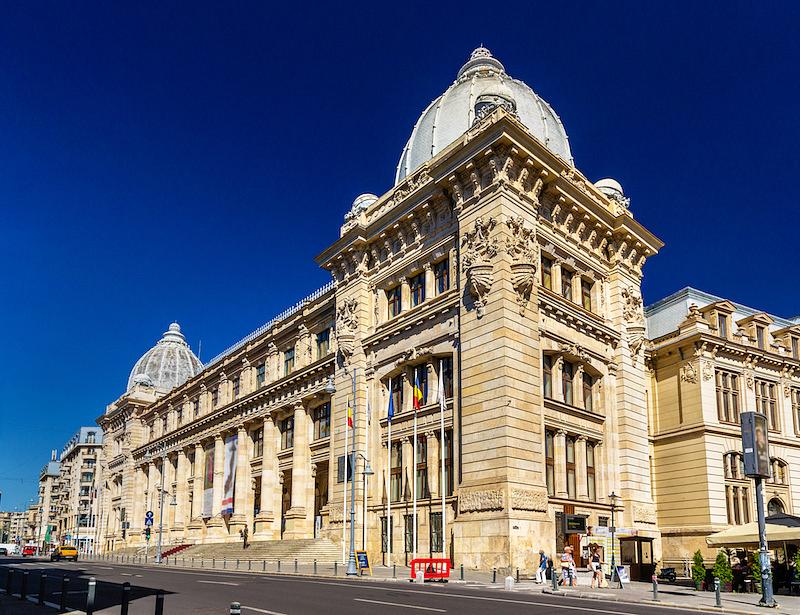Bucharest Centennial: The National History Museum - realms of memory

Romania-Insider.com has started a series of articles about Bucharest landmarks of architecture or history, which have witnessed the last century of what is now the Romanian capital, and noteworthy people which have helped build the Romanian capital as it is today. This project is supported by the Bucharest City Hall through the Public Monuments and Touristic Heritage Administration (AMPT), within the cultural program Bucharest-Centennial.
An imposing and remarkable building on Victoriei Avenue in Bucharest not only hosts important Romanian historic treasures but also “lives” on several layers of rich history of the Romanian capital. It is Romania’s National History Museum, hosted in a building known to architecture aficionados as the Postal Palace, after its initial destination. It’s the best place to learn about the accomplishment of Romania’s Unification and to understand how the capital city was a century ago.
Romania’s National History Museum keeps important documents and objects from the Great Union in 1918, which is celebrated this year. The original document of the Great National Assembly resolution in Alba Iulia from December 1, 1918, written on parchment, is on display in this museum. Through this document, representatives of the regions of Transylvania, Banat, Crișana, Maramureș decided to unite to the Romanian Kingdom, which at the time included Wallachia, Moldova and Bessarabia. As many as 1,228 delegates from all of Romania’s regions voted this resolution. Four years later, King Ferdinand I and Queen Mary were crowned in Alba Iulia. The crowns and capes they wore at the coronation are also on display at the History Museum, thus bringing back to life the Great Union from a century ago.
The building was established at the end of the 19th century, on the premises of the former inn Constantin Vodă, which had burnt down in the great mid-19th-century fire that overtook much of Bucharest. The initial plan was to build a Justice Palace on the plot, after the inn remains were demolished. But lack of funding ended the project, so the land stayed empty. It hosted some barracks, one of which became the Alcazar theater, known for the stage where famous actors such as Matei Millo and Aristița Romanescu used to perform. Later on, a circus took its place around 1870. The idea to build a Postal Palace there came 20 years later.
Romanian architect Alexandru Săvulescu traveled to several cities in Europe to see how their postal buildings looked like, in order to design the Romanian one. He designed the Palace drawing inspiration from the Genève postal building. Construction work took six years, and the Palace was officially opened at the turn of the century. It was one of the first palaces dedicated to postal services built at the time and had a 3,000-line telephony installation, one of the most modern in Europe at the time. It was a heavy upgrade from the 300-line equipment at the Post’s former headquarters.
The building, on four floors, bears the neoclassical style. It has an imposing row of long steps covering its entire façade and 10 Doric columns. At its extremities, the building sports two beautifully decorated cupolas. Two statues, one representing Mercury, the messenger of gods, and the other one depicting Mecanica – or the progress of science, can also be found on the façade. It used to have ten smaller, allegoric statues, which were either destroyed in the 1940 and 1977 earthquakes or demolished to protect passers-by.
The 8,000 sqm building initially had a budget of 3 million lei in that day’s currency but ended up costing twice as much. Most of it came from loans.
The building where Romania’s National History Museum is located today hosted Bucharest’s main postal office for a long time, until 1970. Renovation of the building started then, as it was seriously affected by the 1940 earthquake. Two years later, it was ready to host the National History Museum. When the museum opened, it was the biggest institution of this kind in Romania. It brought under one roof the most important items having witnessed Romania’s past, which attracted, even at the time, many Romanian and foreign visitors.
In 1977, another big earthquake affected the museum building. The latest renovation happened in the early 2000s.
Nowadays, the museum has three permanent exhibitions: the historical thesaurus, the Lapidarium and a replica of the Trajan Column, while its central area often hosts temporary exhibitions. The historic treasury hosts some of the most representative items for Romania’s history, in total, 3,000 such items. Some of the most representative of them include pre-historic and antique artifacts – such as the Hamangia thinker – famous Dacian bracelets, religious objects from various periods, important documents – such as the flying brevet of famous Romanian inventor Aurel Vlaicu, official Romanian king portraits in original, gold and silver coins, as well as royal jewelry – with a highlight on the gold crowns of four late kings and queens of Romania - and items made by famous jewelers, such as Cartier.
How to get there:
The National Museum of History (MNIR) is located at 12 Victoriei Avenue (Calea Victoriei). Visiting hours are Wednesday to Sunday, 10 AM to 6 PM. The ticket desk closes at 5.15 PM. The closest metro station is at Piața Universității. The museum offers guidance in English and in French for groups of up to 25 people.
Photo: Adobe Stock
















